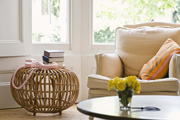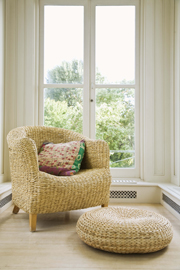
Daylighting
Daylighting can be an energy efficient strategy if electric bulbs are dimmed or turned off when daylight provides adequate illumination. Most daylit rooms average 10 to 12 hours per day of potential lighting energy savings.
In new construction or a major remodeling, consider installing a strategically placed window or skylight. In larger rooms, windows on more than one wall give balanced light distribution throughout the room, reduce glare, and provide cross ventilation. In order to avoid glare, position desks and seating for conversation and reading so that people are not facing the windows. Alternatively, adjust blinds to redirect sun to the ceiling. Transparent curtains and shades can soften direct sunlight. In rooms with windows on only one wall, people seated with their backs against the window may appear as silhouettes to others in the room, who may experience discomfort by trying to see a backlit face against the bright window. Locate tasks that require more light nearer to windows. For instance, place a hobby or homework table next to a window.
A small skylight in a hallway or other room without windows located on the upper floor can provide ambient light. Where possible, design so that all rooms have a window or skylight.
In rooms with television or computer screens, place the screen so that it does not reflect the image of the window in the screen. Hold a mirror in the proposed location of the screen. If you can see the image of a window, bulb, or fixture in the mirror when it is viewed from the intended sitting position, the screen will also reflect that image. Direct sunlight can cause discomfort while watching television, working at the computer, or reading. Nonetheless, for many other less visually demanding tasks, sunlight enlivens the room.
Cautions
- Automatic daylight dimmers that are controlled by photosensors are impractical for most residences because of their high price. Provide separate switches for fixtures in various parts of the room to allow residents to use only the fixtures that they need.
- Depending on climate or building orientation, the use of windows and skylights can have a positive or negative effect on a home's heating or cooling requirements. Windows that are located below table height do not add much lighting benefit but may add considerably to home heating and cooling cost. Daylight may introduce problems such as glare on television and computer screens, fading of fabric and artwork, and thermal discomfort.


